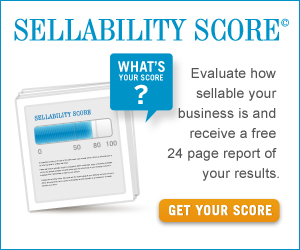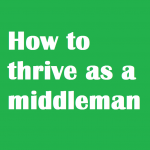Republished with permission from Built to Sell Inc.

Photo by: Kenny Louie licensed under Creative Commons Attribution 2.0 Generic
If your company’s revenue has stalled after a period of rapid growth, you may have fallen into The Mile Wide Trap.
Consider the case of Kim (not her real name) who runs a public relations firm. Kim studied marketing at school and went on to work for a big advertising agency where she spent ten years learning a variety of marketing disciplines, from public relations to advertising to direct marketing and social media.
Then Kim decided to leave her job to start a public relations firm. Given her depth of experience and connections, she quickly landed tractor giant John Deere as a client and was asked to handle their regional dealer events. She hired some helpers and her start-up agency quickly began to grow. Kim did a great job with the dealer events, so John Deere asked her to handle their annual sales conference. Again she delivered with style and creativity.
Impressed by Kim’s innovative approach to the event, John Deere asked her to handle some of the creative for their next advertising campaign. Kim had started her company to do PR, not advertising, but John Deere was a great client so she agreed to help out with the ads.
Then John Deere asked her to take a look at their website. Kim’s new employees had no experience with web design, but Kim had done some website jobs back at the ad agency. Not wanting to disappoint John Deere, Kim started to personally handle projects that her employees didn’t have the ability to execute.
Kim didn’t worry about new business development for own firm because the more John Deere asked Kim to do, the busier – and more profitable – her firm became.
Then one day Kim looked at her monthly P&L statement and realized that, for the first time, their sales were flat on a month-over-month basis. The next month it happened again and then again. Kim had run out of hours in the day to sell – she had inadvertently fallen into The Mile Wide Trap.
The Mile Wide Trap
The Mile Wide Trap ensnares you when you do an excellent job serving a small number of great customers and they ask you to handle more of their work. You keep delivering, and they keep broadening the list of products and services they want you to supply.
Your company is wildly profitable serving the expanding needs of this small list of “great customers” so you keep falling deeper and deeper into the trap.
Pretty soon, you’re an inch deep and a mile wide in offerings and the only person in your company with the depth of industry experience to deliver all of the services is you. But you’re trapped because your expenses have crept up as your revenue has exploded – leaving you dependent on the sales you get from a small group of demanding customers.
With no more hours in the day, your company stalls and you run on a hamster wheel just trying to keep what you’ve got.
The Solution: Sell less stuff to more people.
Instead of selling more things to a few customers, concentrate on selling a few things to a lot of customers.
Nashville-based Ethos3 is a successful design firm that has avoided The Mile Wide Trap. Most design firms are founded by a designer who gets himself in trouble by offering a broad range of design services (brochures, websites, signage, advertising) to a handful of clients. But founder Scott Schwertly knew that in order to scale up beyond himself, he needed his employees to execute the work, and therefore he decided to focus on one very small corner of the design business: PowerPoint presentations.
Schwertly’s focus on PowerPoint has allowed him to train his employees to follow his system for designing presentations. Everything is standardized – from the proposal to project management to the final invoice – so employees can follow a system that doesn’t require Schwertly. Ethos3 has scaled up nicely and counts Microsoft, Google and Cisco among its 300+ customers.
Another example: Flikli.com is a video production studio, but instead of making videos of all kinds, they’ve decided to focus exclusively on two-minute animated “explainer” videos that explain a company’s value proposition simply and effectively. Their focus on creating one specific type of product allows them to standardize their pricing and give employees a step-by-step guide to making great explainer videos. Flikli has scaled up to 22 employees and their work has been featured in everything from Wired Magazine to The Washington Post.
You can fall into The Mile Wide Trap innocently enough: you do great work and a customer wants more of you. But it’s a trap that will eventually choke off your growth. The way out is to follow Flikli and Ethos3 and focus on selling less stuff to more people.
Why not find out now if your business is sellable?
This free online tool is the only no-risk step you can take to determine if your business is ready to get full value. Fast-track your analysis by taking advantage of this free, no-obligation free online tool.
This Sellability Score you instantly receive is a critical component to any business owner’s complete financial plan and is something that, until now, we have only made available to existing clients.
However, we recognized that there is value in knowing in advance of working with a financial planner whether or not your largest asset is ready to be exchanged for your retirement nest egg. Our view is that you are better to learn more about your businesses sellability today and find out how your business scores on the eight key attributes so that you can ensure you obtain full value.
If your business part of your retirement plan, finding out your sellability score will be the best 10 min. you could ever spend working “on” your business.
Take the Quiz here: The Business Sellability Audit
 For more free information on Creating A Business Owner’s Dream Financial Plan, you can listen to a free, eight part series we did exclusively for business owners. The show is also available to subscribe to for free via iTunes.
For more free information on Creating A Business Owner’s Dream Financial Plan, you can listen to a free, eight part series we did exclusively for business owners. The show is also available to subscribe to for free via iTunes.



 Being a middleman (or woman) has become risky business.
Being a middleman (or woman) has become risky business. For your business to be valuable – and sellable one day – you need some way to generate sales after you’re gone. Many business owners hire a superstar salesperson to replace themselves as a rainmaker but that’s a trap.
For your business to be valuable – and sellable one day – you need some way to generate sales after you’re gone. Many business owners hire a superstar salesperson to replace themselves as a rainmaker but that’s a trap. On today’s episode, I interview Jason Kwiatkowski, a Partner with Valuation Support Partners Ltd. We chat about why business valuations are so important to your business and what the major trends are that business owners need to be aware of.
On today’s episode, I interview Jason Kwiatkowski, a Partner with Valuation Support Partners Ltd. We chat about why business valuations are so important to your business and what the major trends are that business owners need to be aware of. I’m going to highlight the single biggest problem business owners face when it comes to their retirement plan, and how the sellability score report can pave the road to solving that problem.
I’m going to highlight the single biggest problem business owners face when it comes to their retirement plan, and how the sellability score report can pave the road to solving that problem.





